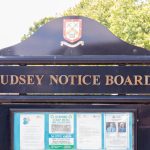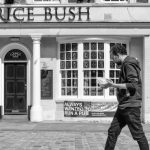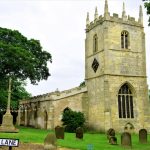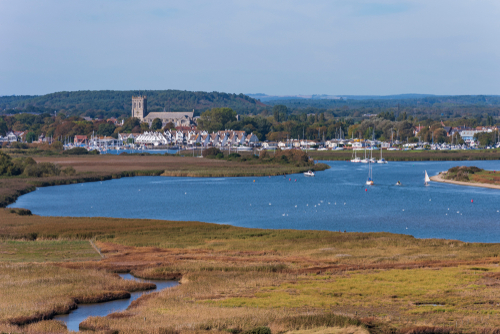
Christchurch in Brief
Christchurch is an ancient town and civil parish in Dorset on the south coast of England. It’s nestled between Bournemouth to the west and the eastern edge of the New Forest. The town was historically part of Hampshire but transferred to Dorset under the local government reorganisation of 1974. In 2019, Christchurch merged with neighbouring Bournemouth and Poole to form the South East Dorset unitary authority. In 2013, the town had an estimated population of 48,368.
A Fleeting History
Early Times
The Christchurch area was reportedly first settled around 650 AD by the Saxons. The settlement lay mid-way between the River Avon and River Stour, so it was named “Tweoxneam”. The name translates to modern-day English as “between two rivers”. By the 9th- century, Tweoxneam was already an important trading and fishing port. Around 890 AD, its strategic importance was recognised by Alfred the Great, as he made it one of his ‘burhs’. The burhs being a network of fortified towns that offered the area protection against the threat of Viking invasion.
The Normans
Around 1094, the Dean of Twynham, Ranulf Flambard, commissioned the building of a priory. According to legend, the construction of the priory was subject to a local miracle. Builders found a crucial roof beam had been cut too short. They set the beam aside, intending to deal with the problem the next day. However, when the builders came to work the following morning they found the beam was already in place and a perfect fit. After completion of the priory, some say inspired by the miracle, the town’s name was changed to Christchurch.
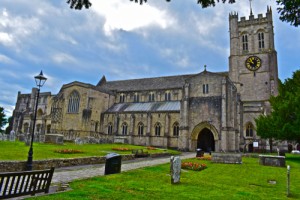
Christchurch Priory was built around 1094: Credit – Colin Burdett/shutterstock.com
In the early 12th century, a wooden fort was built in the town by Richard de Redvers, a cousin of King Henry I. The introduction of a weekly market and an annual fair followed the fort’s construction. Their success encouraged the further development of the town as a fishing port. The wooden fort was soon rebuilt as a stone castle by Richard’s son Baldwin de Redvers. In 1139, he sided with Empress Matilda of Germany in her ambitious bid for the English throne. This subsequently pitted Baldwin against King Stephen, but his new castle proved its worth in resisting royalist forces.
Dissolution and Civil War
In 1539, King Henry VIII’s revolutionary dissolution of the monasteries saw Christchurch’s priory closed down. However, the building was one of the few monasteries that survived the reign of Henry. The 11th century ‘miraculous beam’, as it was dubbed, became the subject of Medieval pilgrimages. It can still be viewed to the present day.
The English Civil War (1642 – 1651) was responsible for further unrest in the town. The castle, originally under royalist control, was captured by Sir William Waller for Parliament in 1644. Lord Goring briefly retook the town for the royalists in 1645. However, his small army under-equipped army was soon obliged to withdraw. Goring returned with a larger force within days and laid siege to the castle. The parliamentarians withstood the blockade and maintained their hold on the town until the end of the war. In 1652, fearing the castle might fall back into royalist’s hands, Cromwell ordered it to be demolished.
A Smuggler’s Paradise
By the mid-17th century, Christchurch’s port was already in decline. Mostly due to the constant silting up of the harbour entrance. Attempts were made to solve the problem but all were unsuccessful. Over the following years, various proposals were made to resolve the problem but none came to fruition.
During the 18th century, smuggling developed into one of Christchurch’s most lucrative industries. The problems with the harbour entrance worked to the smuggler’s advantage as it provided poor access for Customs and Excise officers. Much of Christchurch’s townsfolk were involved in smuggling, enabling some to become relatively wealthy. In 1784, a local confrontation between smugglers and Customs and Excise officers was dubbed the Battle of Mudeford. It saw a Royal Navy officer killed during the skirmish, with the responsible smuggler being subsequently executed.
Industry arrives in Christchurch
Around 1785, Robert Cox began to manufacture the delicate fusee chains that were used in the production of timepieces. By 1793, Cox had gained a monopoly on fusee chain production throughout the country. In 1801, the time of the country’s first national census, the population of Christchurch was recorded as 1,410.
In 1845, William Hart opened another fusee chain factory opened at Bargates, establishing the town as one of the world’s leading producers. However, by 1875, changes to clock and watch designs meant that fusee chains were no longer required, and the industry became obsolete.
In 1847, the railway arrived in Dorset, which saw Holmsley station open, about 6 miles from Christchurch. It took another 15 years before a railway station was built in the town itself, when the Ringwood, Christchurch, and Bournemouth Railway was opened. In 1874, the RC&BR line was purchased by London South West Railway (LSWR). In 1885, LSWR built the present-day Christchurch, the old station being reduced to goods station status.

The railway arrived in Christchurch in 1862: Credit – Arcansel/shutterstock.com
Christchurch in the 20th Century
In 1901, the population of Christchurch was a modest 4,204. However, the beginning of the 20th century saw some significant improvements to the town. In 1902, the council began to lay the town’s first mainline sewers. In 1903, the first public electricity generating station opened. In 1905, trams were introduced to Christchurch’s streets, though their operation used up much of the town’s available power supply. Nonetheless, trams ran until 1936 when they were replaced by electric-powered trolleybuses. The trolleybuses operated until 1969 when they themselves were replaced by conventional buses.
Like many places across the country, slum clearance across the town began in the 1930s. In 1934, the Fisher Aviation Company built an airfield in the Somerford area. During, WW2 Airspeed built a factory on the airfield to manufacture aircraft for the RAF. In 1944, the USAAF 9th Air Force also established a base at the airfield. Also in 1944, a second aerodrome opened at Hurn, which would later become Bournemouth Airport.
By 1951, the population of Christchurch had risen to around 20,000. A major event for the town occurred in 1958 when the A35 Christchurch By-pass opened.
The Modern Era
Following the 1974 local government reorganisation, Christchurch was transferred from the county of Hampshire to Dorset and subsequently granted borough status. In 1975, the town was twinned with Christchurch, New Zealand. In 1983, a new shopping precinct opened in Saxon Square and the Regent Centre also opened.
Some of the biggest employers in Christchurch are the aviation, communications, and transport sectors. Although the town is not heavily dependent on tourism, it still attracts some 850,000 visitors per year, albeit most are day-trippers. Tourism is estimated to add around 9% to the local economy.
Christchurch is twinned with Aalen in Germany; Tatabánya in Hungary; Saint-Lô in France; and Christchurch in New Zealand.
Getting to Christchurch!
By Road
Take the M3 out of London and follow it southwest, then take the M27 and A31. At Ashley Heath roundabout take the A338 for Bournemouth. You’ll see the signs for Christchurch from the A338 as you approach Bournemouth. There are various ways to get there from the North and Midlands. Head to Salisbury to get on to the A338 (just south of the town) is probably one of the easier ways to get to Christchurch.
By Rail
Christchurch is on the South Western Main Line from London Waterloo to Weymouth. Services are operated by South Western Railway and depart for London approximately every 30 minutes. From the Midlands and the North, it’s probably easiest to change at Bristol.
By Air
Bournemouth Airport is located only 4 miles northwest of Christchurch.
What to see and do around Christchurch?
You may be surprised at the variety of things you can do in or close to Christchurch. Here are a few suggestions:
Hit the Beach!
If hitting the beach is your thing, then you’ll find Christchurch a paradise, as there are seven locally. Most are a mix of sand and shingle, though there’s a couple that is shingle only. Avon beach and Friar’s Cliffe beach are the closest to the town, the most popular, and have the most amenities. Gudimore, Hungisbury Head, Highcliffe Castle, and Highcliff beaches, along with Mudeford sandbank are the others.
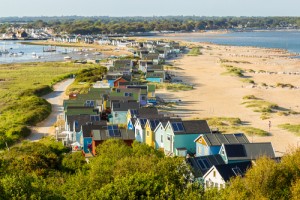
Hungsbury Head Beach: Credit – Gyorgy Kotorman /shutterstock.com
All Hands on Deck!
Many agree that one of the most enjoyable things to do in Christchurch is to hire a boat. You can rent one from Quay Leisure Boat Hire at the Quayside for as little as half an hour. Boats carry up to 6 passengers, you don’t need any experience or license, so why not test your nautical capabilities?
If you don’t fancy rowing your own boat, you can take a vintage ferry run by Bournemouth Boating, instead. Their ferry service runs from Tuckton Tea Gardens to Mudeford Sandbank. The ferry stops at Wick Ferry and Quayside, along the way.
Maybe you are more of an adrenaline junkie? If so, you can rule the waves with Adventure Voyages. They offer the chance to explore the local coastline in their purpose-built 30-ft rigid inflatable boat (RIB). The truly exhilarating rides take in the Needles, the Isle of Wight, or other local sites.
Explore Old Christchurch
If you’re a confirmed landlubber then perhaps old ruins are your thing? If so, you’re in luck because the ancient town of Christchurch has more than its fair share. Two of the town’s most impressive ancient buildings are right in the centre. The 11th century Christchurch Castle overlooks the priory it was built to protect. The nearby Constable’s House dates from 1150 and is reputed to have one of the oldest purpose-built chimneys in Britain. You can visit both attractions for free!
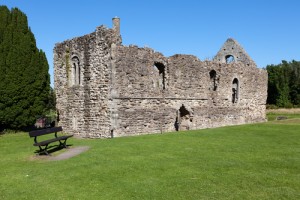
The Constable’s House: Credit – Jo Chambers /shutterstock.com
Arguably, Christchurch Priory, which was built in 1094, is the town’s most significant building. It happens to be the longest parish church in the UK. You can visit the church almost every day, although times are restricted on Sundays. While it’s free to visit the church, there’s a nominal charge for the Tower Tour. Master the 176 steps of the ancient spiral staircase to the top tower and you’ll get spectacular panoramic views across the town.
The Red House Museum might not be ancient but it’s pretty old. The stately red brick building was constructed in 1764 as the parish’s poorhouse. Today, the Red House showcases the history of the town, from its ancient Saxon beginning through to Edwardian times.
Highcliffe Castle is a spectacular, Grade-I listed property that was built in 1836. Perched on clifftops near Christchurch, it has fantastic views across to the Isle of Wight. It’s set in 14-acres of grounds which are a popular spot for walkers and picnickers, alike.
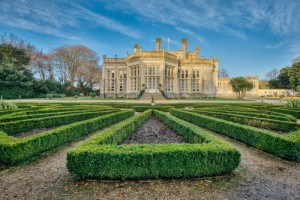
Highcliffe Castle: Credit – tommyscapes/shutterstock.com
Hiking and Biking
Whether you just want to take a gentle stroll or thinking of taking on a long-distance hike, you’ll find options in and around Christchurch. The Stour Valley Way is a 64-mile long-distance footpath that runs from Stourton in Wiltshire to Hengistbury Head in Christchurch. The route more or less follows the River Stour. The Avon Valley Way is a 34-mile footpath that follows the River Avon from Salisbury to Christchurch. Popular short coastal path routes include the 7.7 miles Christchurch to Bournemouth. There’s also the 6.7-mile walk from Christchurch to Barton-on-Sea in the New Forest, and the 4.8-mile circular walk to Hengistbury Head.
There are at least 20 official cycle routes that loop around Christchurch. The routes vary in difficulty and length i.e. from around 10 miles to more than 50 miles. There are also plenty of cycling tracks through the nearby New Forest. Biles can be hired locally at reasonable rates.
Boutique Shopping
If you don’t mind shelling out the few extra quid for a bespoke shopping experience, then Christchurch should not disappoint. The Emporium in Bridge Street is a large shopping centre with an eclectic mix of more than 130 retailers. There you’ll find everything from fine art to vinyl, and from crafted gin to vintage fashion. There’s also a traditional street market that sets up in the High Street every Monday.
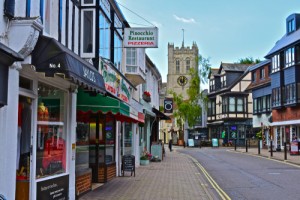
Christchurch is known for its bespoke shops: Credit – Colin Burdett/shutterstock.com
Events and Festivals
Christchurch hosts more than its fair share of festivals and events throughout the year. Highcliffe Food and Arts Festival is a 2-day event that celebrates local and regional food, drink, and art, usually held in mid-June. Next on the agenda is ”Stompin’ on the Quomps”, which takes place in early August. It’s one of the largest jazz festivals of its kind in the UK.
Just a week or two later is the annual Christchurch Carnival. The 2-day carnival has entertainment, live music, and a fireworks display. The Carnival ends with a parade through the town’s streets. The Christchurch Food Festival is a huge open-air food event, with stalls, cookery shows, and entertainment. It’s staged just another 2 weeks after the town carnival.
Other annual events include the week-long Christchurch Priory’s Music and Art Festival held at the Priory Church. The Mudeford Seafood Festival is a family-orientated event of seafood, cooking, and entertainment, all at a seaside location. Then there’s the Christchurch Regatta, which is held each summer.
A Few Notable Residents
- John Stuart (1713 – 1792) – 3rd Earl of Bute, and British Prime Minister between 1762–63, once owned a house in Christchurch.
- Sir Donald Bailey (1901 – 1985) – was a civil engineer who developed the Bailey bridge He lived and worked in Christchurch during WW2. He returned to the town in 1966 after his retirement and remained until he died in 1985.
- Robert Southey (1774 – 1843) – writer, poet, and Poet Laureate; lived in nearby Burton between 1797 and 1799.
Sport In Christchurch
Christchurch FC plays its football in the Wessex League Premier Division. Nicknamed ‘The Priory’ the club plays home games at the Hurn Bridge Sports Ground.
Christchurch Cricket Club field several teams in the Dorset Saturday and Sunday leagues. The club plays home matches at the Hurn Bridge Sports Ground.
Not too surprisingly, sailing is a popular activity in Christchurch. The harbour is home to three sailing clubs: Highcliffe Sailing Club, Mudeford Sailing Club and Christchurch Sailing Club.
Where to Stay?
There are loads of choices when it comes to accommodation in Christchurch. Depending on whether comfort or budget is your priority, there’s plenty of self-catering, guesthouses, boutique B&Bs, quality hotels, or holiday and caravan parks, as options.
Thinking of moving to Christchurch?
Properties in Christchurch have sold for an overall average price of £436,000 over the last year (July 2021). Most of the sales were for detached properties which sold for an average price of £536,400. Semi-detached properties sold for an average of £340,100, while terraced properties fetched around £376,100. The sold price of houses in Christchurch for the year was about 8% up on the previous year.
Header image credit: allouphoto/Shutterstock.com
